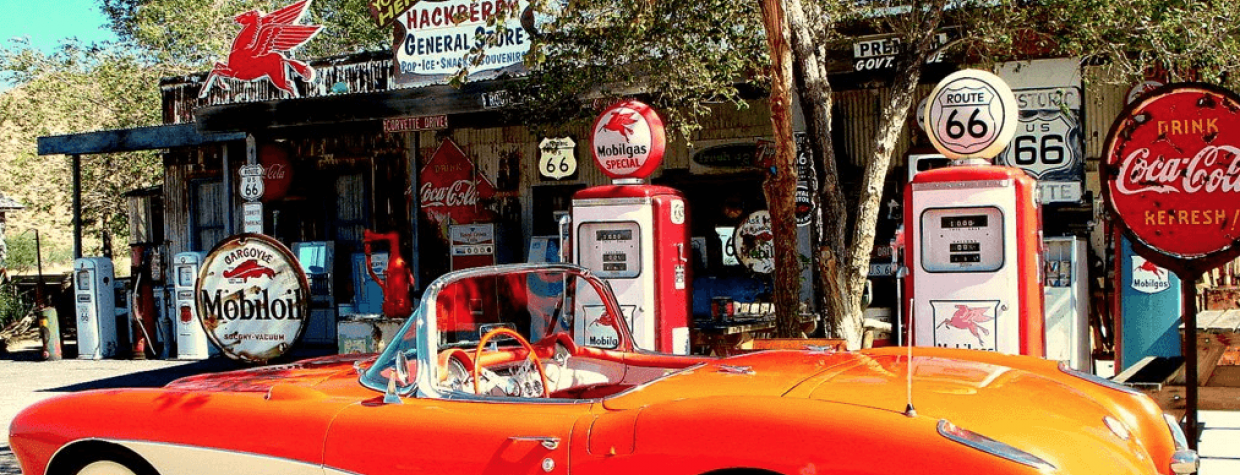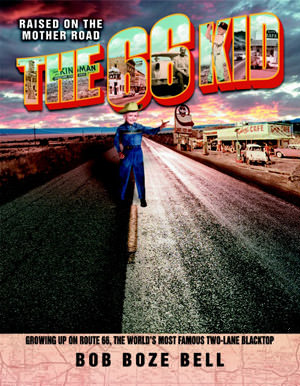Historic Route 66 contains a kind of nostalgic awe, the fading memories of a bygone era. The 66 Kid, a new book from Bob Boze Bell, an artist and editor of True West magazine, revives those memories on the page through pictures, maps, graphics and cartoons. It’s a graphic novel of sorts — at least, that’s how Bell sees it.
The book is about 70 percent visual and 30 percent text, Bell says, and it weaves together a portrait of his own life with the world of ’50s and ’60s Kingman along the famous highway. From the inclusion of personal photos and postcards to museum archives, The 66 Kid illustrates Route 66 from the perspective of someone who grew up on it. Bell spoke with us about his book and the process of putting everything together.
Tell us a little bit about your inspiration. Where did the idea for this book come from?
I always kind of knew I wanted to do a book on growing up on Route 66, and then I had a heart attack while playing the drums at a band reunion in 2008, so that was a wake-up call. I thought, “If I’m ever going to do it, I better get my little patootie in gear.” And I really started to get serious about it. I had a friend in Kingman who does Route 66-themed books, and he turned me on to his publisher, and they bought the idea and we were off to the races.
You have a friend who does Route 66-themed books?
Yeah. His name is Jim Hinckley, and he’s got eight books out on it, and I just called him up and I said, “Hey, would your publisher be interested in a book about growing up on Route 66 as it applies to Kingman?” And he says, “Well, that’s pretty specific.” I said, “You know, that’s the book I want to do.” And they bought it.
Tell us about the research you had to do to complete the book.
I knew I needed historic photos, and for that, I was really blessed by the fact that my mother kept really good scrapbooks, and she had fantastic photos. I also had 8mm film, because when I grew up in the gas station, my father would get broke tourists coming in and trying to make it to California, and he’d bill them every day with different prices, like binoculars and Bowie knives. He came home one day with an 8mm camera, and I started taking film. So, I had a lot of film, original footage of my dad’s gas station in the 1960s. I really had a lot of stuff.
I still needed more, and by that, I went to the Mohave Museum, and they allowed me to use their photos. So, between all three of those, and then I used a person who we call “The Mapinator,” Gus Walker — he does stuff for me at True West. Between all those different venues, we had a great visual attack.
Tell us about the visual focus of your book.
It’s very Americana, very ’50s, a lot of coonskin caps, ’57 T-Birds, full-service gas stations. Really, it’s a road picture. It’s a road picture on paper.
How did you select which parts of your own life you would include?
The ones that I could print and that my grandson could read — that was the criteria. I was a rock ‘n’ roll drummer and underground cartoonist, so I led a very, shall we say, “colorful” life. I wanted to be honest, and I wanted to not leave things out, but I wanted to, at the same time, tell the story as a celebration of being on Route 66. That colored some of the text. It’s the PG version of an X-rated life, let’s put it that way.
What was the most difficult part of putting the book together, and what was the most rewarding?
It was really tough. The deadline was to do 16 pages a week for 12 weeks, and we started on January 3 of this year. By we, I mean my art director and I, Dan Harshberger — we grew up together in Kingman, so this is a project of love for us, a love letter to our hometown. We had to hand in 16 pages a week, and that was laid out, with photos and captions and spell-check. That was the hardest thing I’ve ever had to do in my life. I’m a deadline person, and I’ve worked on deadline my whole life, but that was really almost insurmountable. But when we got it done, it was something I’m very proud of.
So is that what you would say was the most rewarding part?
About the book? Yeah, the book. And actually having — I’ve had people approach me and say, “You grew up in Kingman, right?” And I’d say yeah. And they’d say, “Well, I’m a postcard collector, and I have a postcard of the Hillcrest Motel; where was that?” And I’d say, “Well, it was right across from the Kingman Motel and catty-corner from my dad’s gas station, Al Bell’s Flying A.” It dawned on me after three or four questions what we take for granted [because] we grew up there. We just assumed that everybody knew where all these businesses were, but when you go up there today, it’s really hard to envision where all these things were. So one of the critical components of the book is to have a five-page map section showing where all the businesses on Route 66 going through Kingman were.
Why should people care about Route 66? Why are these stories important?
I didn’t understand this when I was growing up. This road that my parents made a living on — my mother worked in the highway department, my dad had a gas station, and I worked for tips in the gas station — and I didn’t understand it. This road, to me, was just another road. I finally realized when I was in Spain on assignment to find “Cowboy Ground Zero” for our True West magazine. I was standing on the beach where Columbus left on his second journey to go to the New World and bring cattle and horses, which led to the vaquero and ultimately the cowboy — I was just thinking about how important this was. After about 10 minutes of standing there, I turned around, and there on the beach was the Route 66 Bar. In Spain. So I went, “Oh, I get it. I get it. This is a big deal. What goes around comes around. This thing is a big deal worldwide.” And I thought, “I’m going to do in-depth reporting about a very specific part of Route 66 and what it was like to grow up on the world’s most famous two-lane blacktop.”
Where can the public learn more about you and your book?
You can go to www.truewestmagazine.com, where I do a blog, and you can see more about the pictures of the book there. You can go to www.bobbozebell.net, which is where all my artwork is. Between those two things, you’ll get more of Bob Boze Bell than you ever wanted.
— Molly Bilker


